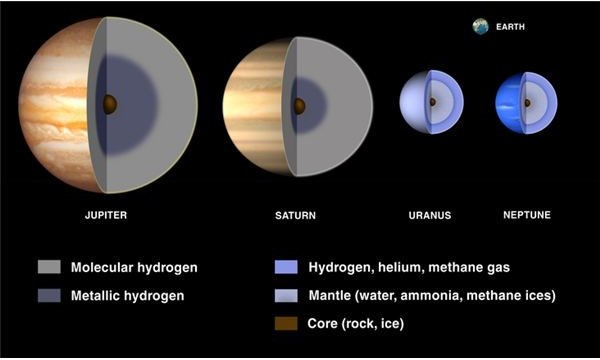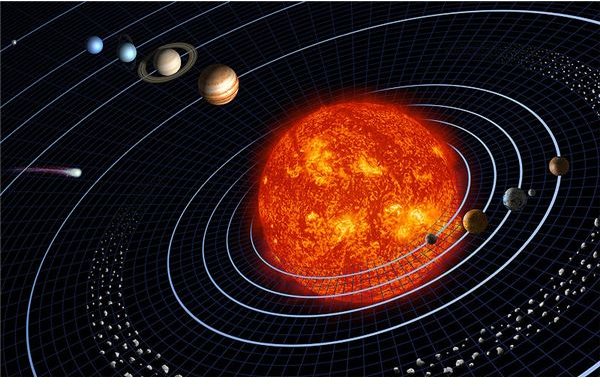A Journey to the Inner and Outer Planets of Our Solar System
Introducing the Structure of Our Solar System
Our Solar System comprises of the eight known planets divided into two categories - the inner and the outer planets. The first group consists of the four ones that are closest to the Sun: Mercury, Venus, Earth, and Mars. They are also called terrestrial or rocky planets and are separated from the second group by the asteroid belt, a region occupied by numerous asteroids. Further from this area and the Sun, lie the outer or gaseous planets: Jupiter, Saturn, Uranus, and Neptune.
“Why is our Solar System structured this way?”, one might ask. During the first stages of formation, the gases near the Sun were blown away by the solar wind or vaporized by the extreme temperatures. The result was that the planets closer to the Sun were left only with their rocky and heavy element materials, while the most distant ones maintained their gaseous form and continued to grow by accumulating even more gas. This is one of the current theories of how the Solar System formed.
The categorization however, does not rely solely on the distance of the planets from our Sun. Their differences are numerous and more profound.
Image: A Solar System depiction showing the four inner planets (Mercury, Venus, Earth and Mars) on the right and the four outer planets (Jupiter, Saturn, Uranus and Neptune) on the left. The asteroid belt is in the middle.
Nine Major Differences

Size: One of the basic differences is related to the size of the planets. The inner planets are small; Mercury is the smallest with a diameter of 4,878 km or 3,031 miles and Earth the biggest one with a diameter of 2,756 km or 7,926 miles. The outer planets are much larger with Jupiter having the largest diameter among them and Neptune the smallest (142,984 km or 88,846 miles - and 49,532 km or 30,779 miles respectively).
Density: The terrestrial bodies are denser, smaller and more solid than the gas giants. The elements of the latter are less densely packed, resulting to a smaller overall density.
Composition: Although the big outer planets consist of gas layers and liquid cores, the case is quite different with the terrestrial planets. Mercury’s consists of iron and nickel and Venus has a rocky surface similar to Mars. The characteristic red color of Mars however, is due to the high concentration of iron on its surface.
Atmosphere: The atmospheres of the rocky planets vary a lot. Earth has an atmosphere mostly consisting of nitrogen, a small percentage of oxygen and smaller amounts of other gases. Carbon dioxide and small amounts of nitrogen can be found on both Venus and Mars, and Mercury almost lacks any significant amount of gas. All giant planets have similar atmospheres mainly consisting of hydrogen, helium, and additionally methane in the case of Uranus and Neptune.
Spinning: The small planets rotate at a much slower pace that the bigger ones. To make some comparisons, Venus takes 243 days to spin around its axis, whereas Jupiter takes only 9 hours and 55 minutes. Such a fast rotation causes the big giants to appear squashed and therefore wider across the equator than from the poles.
Orbit: A complete orbit for the planets close to the Sun ranges from 88 to 687 days. The time scale for the outer Solar System is measured in years due to the longer orbits the planets have to cover. Jupiter makes a complete revolution in 12 years and Neptune in 164 years.
Existence of moons: Only one moon orbits the Earth (Moon) and two orbit Mars (Phobos and Deimos). The situation is very different with the large gaseous planets however. Jupiter alone has 63 known moons and Saturn has 60. Uranus and Neptune have 27 and 13 moons respectively.

Existence of rings: A common feature among the planets of the outer Solar System is the fact that thin rings or discs of dust particles and rocks orbit around them. Saturn’s ring system is the most striking.
Heat Emission: Gas giants emit more heat compared to the terrestrial planets as a result of the planets’ final phases of contraction. The heat emitted by the small planets is due to slow radioactive decay of isotopes, a mechanism that produces smaller amounts of heat. Uranus is the only exception.
Exploration Stages
Many important space missions (Mariner, Viking, Magellan missions) were targeted towards the exploration of the inner Solar System, especially Venus and Mars, due to their proximity to our Earth. Despite this fact, there have been multiple visits to Jupiter and Saturn as well (Pioneer 10 and 11, Voyagers 1 and 2). Voyager 2 continued even further out in the Solar System to explore Uranus and Neptune. The most recent mission involved the Cassini-Huygens spacecraft that was sent to become a Saturn orbiter.
In the late 1990s, NASA proposed two other spacecrafts, Europa Orbiter and Pluto-Kuiper Express, for visiting the outer regions of our system. Both missions were canceled in 2002, but may reemerge in the future_._
Sources:
- Cessna A. “Inner and Outer Planets”, UniverseToday.Com
- SSS The Planets, SolarSpace.co.uk
- “Differences between the Inner and Outer Planets”, BobtheAlien.co.uk
- Enchanted Learning, EnchantedLearning.Com
Image Credits:
- A Depiction of our Solar System by NASA (commons.wikimedia.org)
- The Internal Structure of the Terrestrial Planets by NASA
- Interior of Gas Planets by NASA
